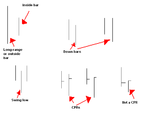This journal thread is a follow up to my earlier ramblings in the Price Volume forum.
I aim to define and test a strategy based on price bars.
A lot of the foundations have been 'borrowed' from Dunnigan, although the strategy I have in mind is not a copy of his work.
The trading plan will be 100% programmable with no room for subjectivity/interpretation/emotion.
Although I have made a big song and dance about trading with price alone, I am reluctantly forced to use a moving average to define trend. If I find a better (programmable) method of telling the trend, I'll stop using the MA.
In the next few posts I will describe the building blocks and the definitions I am going to use.
I aim to define and test a strategy based on price bars.
A lot of the foundations have been 'borrowed' from Dunnigan, although the strategy I have in mind is not a copy of his work.
The trading plan will be 100% programmable with no room for subjectivity/interpretation/emotion.
Although I have made a big song and dance about trading with price alone, I am reluctantly forced to use a moving average to define trend. If I find a better (programmable) method of telling the trend, I'll stop using the MA.
In the next few posts I will describe the building blocks and the definitions I am going to use.
Last edited:

